YOSEMITE CONSERVANCY



Caring for Iconic Trails
Beyond the Valley: Trails Less Traveled
Expert Insights with Yosemite Naturalists
Q&A with Yosemite Insiders
YOSEMITE CONSERVANCY COUNCIL MEMBERS
CHAIR
Bob Bennitt*
VICE CHAIR
Dana Dornsife*
PRESIDENT & CEO
Frank Dean*
Hollis & Matt Adams*
Jeanne & Michael Adams
Gretchen Augustyn
Jenny Augustyn & Ali Meghdadi
Suzy & Bob Bennitt*
David Bowman & Gloria Miller
Marilyn & Allan Brown
Steve & Diane Ciesinski*
Kira & Craig Cooper
Hal Cranston & Vicki Baker
Carol & Manny Diaz
Leslie & John Dorman*
Dave* & Dana Dornsife*
Jewell* & Bob Engstrom
Kathy Fairbanks
Sandra & Bernard Fischbach
Cynthia & Bill Floyd*
Jim Freedman & Karine Joret
Susan & Don Fuhrer*
Bonnie Gregory
Rusty Gregory*
Karen & Steve Hanson
Laura Hattendorf & Andy Kau
Chuck & Christy Holloway
Christina Hurn & Richard Tassone
VICE PRESIDENT & COO
Jerry Edelbrock
CHIEF FINANCIAL OFFICER
Kevin Gay
Jennifer & Gregory Johnson
Walt Lemmermann
Melody & Bob Lind
Sam & Cindy Livermore
Steve Lockhart & Karen Bals
Anahita & Jim Lovelace
Mark Marion & Sheila Grether-Marion
Patsy & Tim Marshall
Kirsten & Dan Miks
Robyn & Joe Miller
Kate & Ryan Myers
Janet Napolitano
Dick Otter & Judy Wilbur
Sharon & Phil Pillsbury*
Gisele & Lawson Rankin
Bill Reller
Pam & Rod Rempt*
Frankie & Skip Rhodes*
Liz Robbins
Dave Rossetti & Jan Avent*
Lisa & Greg Stanger*
Jennifer & Russ Stanton*
Ann* & George Sundby
Clifford J. Walker*
Wally Wallner* & Jill Appenzeller
Jack Walston & Sue Estes
Helen & Scott Witter
YOSEMITE NATIONAL PARK
Superintendent Michael Reynolds
*Indicates Board of Trustees
Yosemite Conservancy inspires people to support projects and programs that preserve Yosemite and enrich the visitor experience.

“Never follow anyone else's path, unless you're in the woods and you're lost and you see a path. Then by all means follow that path.”
— ELLEN DEGENERES’ll add a caveat to Ellen’s wise words: In Yosemite, whether you’re in the woods or zigzagging above tree line, it’s generally a good idea to follow a pre-existing path, even if you’re not lost.
Fortunately, the park’s hundreds of miles of trails offer ample opportunities to chart your own adventure and find or reconnect with favorite spots. (My favorite trails are in the Cathedral Range — they feature spectacular views of domes and glaciated peaks.)
In this issue, we’re exploring how projects and programs you support help people adventure and learn on Yosemite’s trails.
When struggling up a steep Yosemite Valley trail, I often marvel at how the route was chosen and built. In these pages, you’ll see how the Valley’s “legendary” trails took shape, and how donors’ gifts help restore those historic paths. You’ll also learn about the new Washburn Trail to Mariposa Grove, which follows the route of an old wagon road that Chinese laborers helped build over a single winter!
Elsewhere in this issue, a story about donor-funded youth programs highlights how trails serve not only as physical paths, but also as portals to new experiences and ideas.
As you read about our Outdoor Adventures and peruse tips from naturalists, I hope you’ll find inspiration for own treks on the trails. In the meantime, check out our beautiful new website at yosemite.org — your digital pathway to Yosemite adventure and memories!
Enjoy the magazine, and thank you for your support.
COVER PHOTO Backpackers hike near Cathedral Peak, in Yosemite’s high country. Support from Conservancy donors has improved miles of trails throughout the park, with a focus on protecting habitat and ensuring safe, enjoyable hiking experiences.
Frank Dean, PresidentPHOTO: © YOSEMITECONSERVANCY/KEITH WALKLET.
Connect with us online! Follow Yosemite Conservancy, and stay connected.

AUTUMN.WINTER 2019 VOLUME 10.ISSUE 02


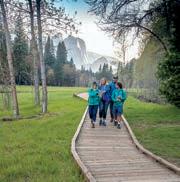

04 TAKING CARE OF LEGENDARY TRAILS
Learn about the positive impact of donorfunded restoration projects on Yosemite’s iconic Valley trails.
08 BEYOND THE VALLEY: TRAILS LESS TRAVELED
Discover how top-tier NPS crews work with the California Conservation Corps to complete critical wilderness restoration work.
10 HIKING, ELEVATED
Learn how Conservancy-funded boardwalks allow visitors to experience Yosemite's wetlands while protecting ecosystems below.
12 NATURALIST NOTES: TRAILS FOR EVERY SEASON
Get inspired for your next outing on the trails with expert tips and tricks from Conservancy guides.
14 Q&A WITH A YOSEMITE INSIDER
Learn about the critical role Conservancy volunteers play in the park.
16 WEBSITE UPDATE
Have you visited us online lately? We’re excited to share our redesigned website, yosemite.org!
17 GRANT UPDATES
Learn about Conservancy projects that promote cycling in the park, inspire youth stewardship and more.
20 PROGRAM UPDATES
Discover wintertime Outdoor Adventures and go behind the scenes with the Conservancy’s Wilderness team.
22 ANNU AL REPORT EXCERPT
See the impact of your gifts in Yosemite.
26 WHY I GIVE
Conservancy donors share their stories of inspiration and passion.
28 PUBLISHING
Explore Yosemite through a naturalist’s eyes with The Nature of Yosemite, a new Conservancy book by Robb Hirsch.
30 READER PHOTOS
Yosemite Conservancy supporters share their special Yosemite memories.

How your support helps Yosemite Valley’s famed hiking routes
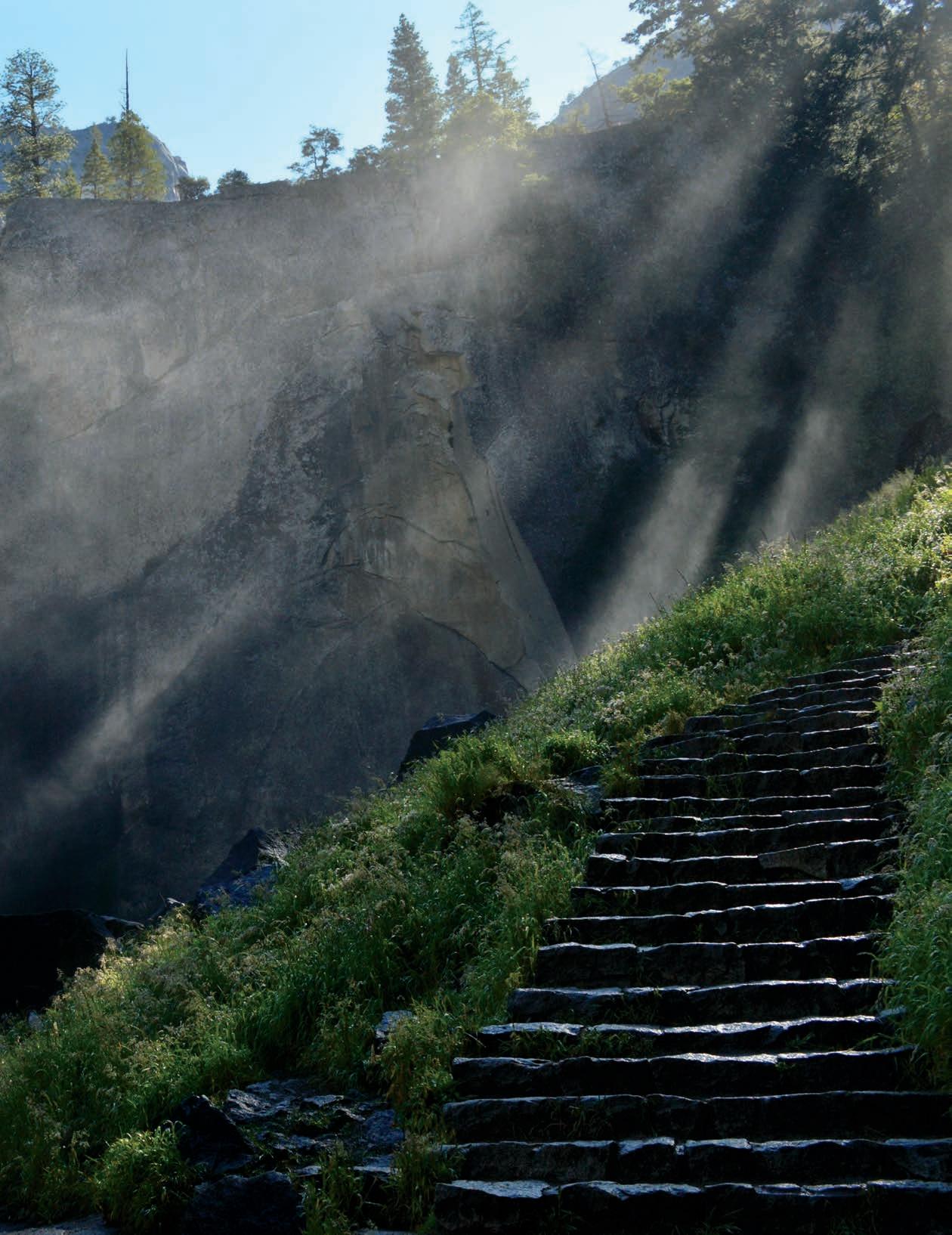
egendary: a common adjective for the trails leading around and out of Yosemite Valley — with good reason. They feature famous spray-soaked steps, eye-popping sights and heart-pounding inclines. In many cases, they’re also rooted in a history that predates the National Park System.
For millennia, American Indians followed game trails, trade routes and footpaths throughout the Sierra, from the trans-range “Mono Trail,” to the western slopes’ sequoia groves, to the floor and rim of Yosemite Valley.
In the 1800s, a network of tourist-oriented trails emerged in the Valley. Some were in place before the 1864 Yosemite Grant Act; others started soon after as toll trails, or took shape decades later.
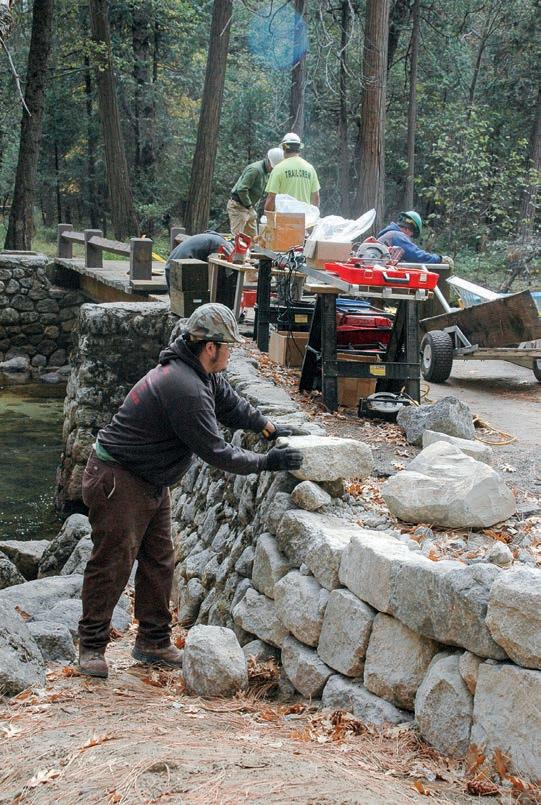


Today’s Valley trails provide safe routes for hikers, and protect meadows, riverbanks and waterfall spray zones from foot traffic while welcoming thousands of people on busy days.
Frequent footsteps, plus rockfalls, floods and other natural events, leave a mark. By funding essential repairs and restoration work, your support ensures the Valley trails’ legendary status lives on.
A trail along the Merced River to Vernal Fall was already in place by the 1860s, when the Yosemite Grant’s commissioners added a bridge above the fall to help people reach nearby Nevada Fall. By the 1870s, the trail featured a toll-collection house and a hotel; those structures are long gone, but the basic route remains.
Today, you’ll find evidence of donors’ gifts at work throughout the 2.7-mile hike to Vernal and Nevada falls: Conservancy-funded projects have added sustainable trail tread; repaired avalanchedamaged railings; expanded Preventive Search and Rescue activities to keep hikers safe, especially on spray-soaked steps; and protected trailside vegetation.
Renowned trail-builder John Conway constructed a trail to the top of Yosemite Falls in the 1870s; he operated it as a toll route before selling it to the state in 1885.
As in the late 1800s, today’s Yosemite Falls Trail features unrelentingly steep terrain — and rich scenic rewards. The 3.6-mile trek yields jaw-dropping views and an up-close look at California’s tallest waterfall. The seasonal efforts of National Park Service and California Conservation Corps crews keep the trail hazard-free; one year, for example, donor-funded crews repaired a 60-foot-long trench and added rock steps and walls to prevent future erosion.
In the 1870s, entrepreneur James McCauley hired John Conway to create a trail linking his Glacier Point hotel with the Valley floor. The original trail spanned about 4 miles; a half-century later, a reroute stretched the length to nearly 5 miles.

The modern Four Mile Trail, which kept its now slightly misleading name, zigzags more than 3,000 feet up the Valley’s south wall; offers views of Yosemite Falls, El Capitan and Sierra peaks; and requires regular repairs, especially after harsh winters. Conservancy-funded restoration work has included clearing debris from rockfalls, rebuilding eroded switchbacks and reconstructing damaged walls.
The 13-mile Valley Loop got its name decades after neighboring trails, but like its legendary peers, it is rooted in the past. The loop, which follows remnants of early equestrian paths and wagon roads, leads along the meadow-flanked Merced, through oak woodlands, by famous formations such as El Capitan and Cathedral Rocks, and to views of year-round and seasonal waterfalls.
The Loop Trail sticks to gentler terrain than its peers leading out of the Valley, but it still benefits from seasonal checkups. Donorsupported work has included removing storm-felled trees, building steps on a section by Mirror Lake, and placing stones to help hikers ford Royal Arch Creek.
Your support has helped keep Yosemite Valley’s legendary trails in top shape — and ensures they can continue to welcome generations of future hikers.
Before you hike, plan your route, and check weather and trail conditions — rangers and Conservancy volunteers are a great source of up-to-date information!
Pack water and snacks, clothing layers, a headlamp or flashlight, and a map (don’t rely on cell service for navigation).
Stick to formal trails. Respect closures, follow switchbacks, and stay back from rivers and waterfalls.
Take time to enjoy seasonal sights, sounds and smells. Examine leaf veins and hoarfrost; listen for woodpeckers and chickarees; inhale the perfumes of pines and damp earth.
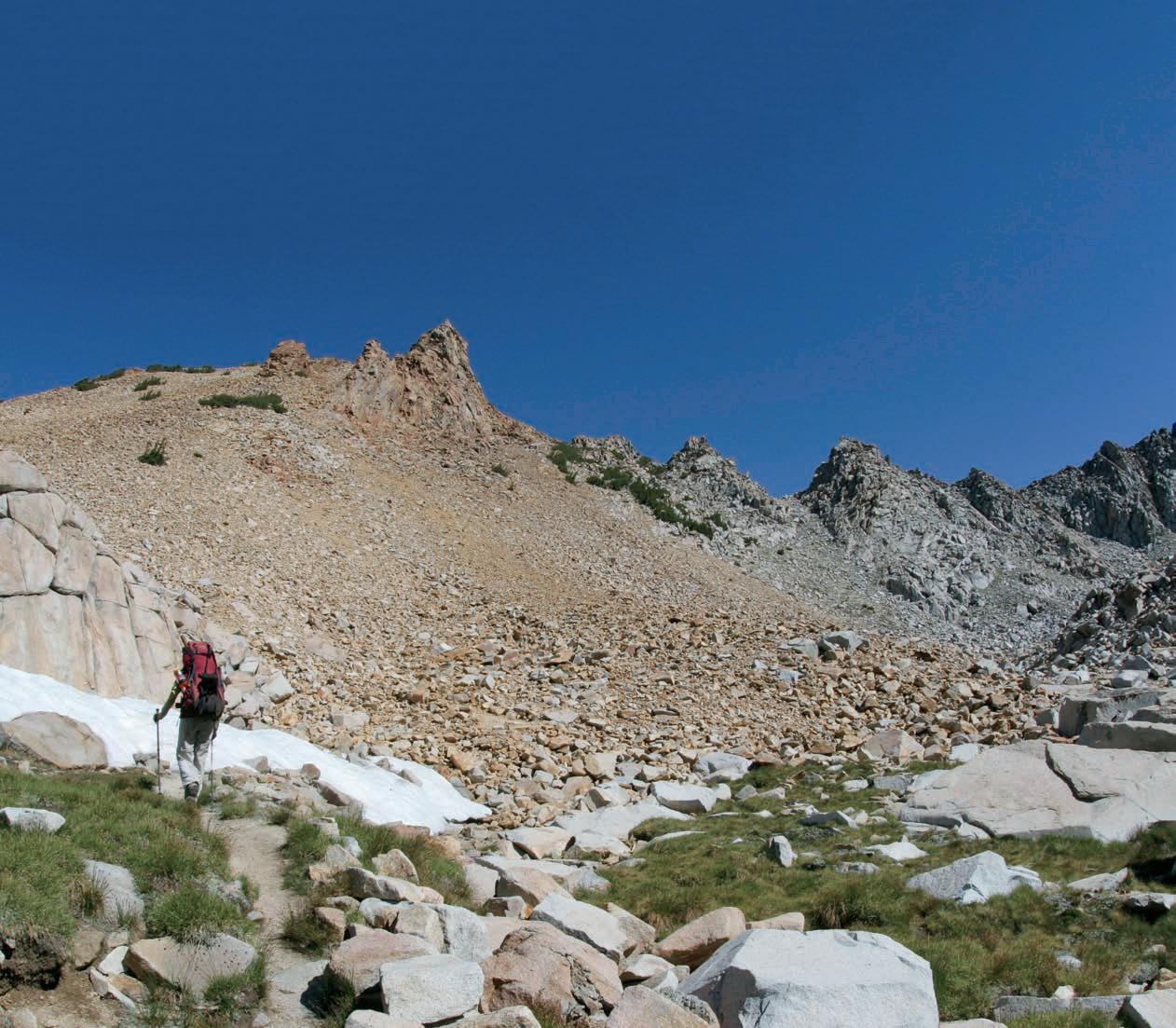
osemite Valley covers less than 1% of the park’s nearly 750,000 acres. While many visitors focus their hiking within that famous sliver of the Sierra, whether zigzagging to the rim or exploring the floor, hundreds of miles of trails extend far beyond the Valley, into the Yosemite Wilderness.
The park’s more remote routes receive less foot traffic than their well-trodden frontcountry fellows, but damage from natural events and hiking builds up over time. Storms down trees and scour gullies. Rockfalls
block paths. Skipped switchbacks squash plants and accelerate erosion.
Conservancy donors have supported trail work throughout Yosemite’s Wilderness, enabling top-tier National Park Service (NPS) crews and young adults from the California Conservation Corps (CCC) to complete critical restoration projects.
Working on Yosemite’s wilderness trails requires time, patience and plenty of sweat. Crews trek to remote areas, hauling camping gear and restoration equipment,
such as axes, picks and shovels. From temporary base camps, they “spike out” to work sites, sometimes hiking miles each morning and evening. During the day, they rely on muscle power and nonmotorized tools to move rocks and logs.
You can see the work of grant-funded NPS and CCC crews’ work throughout the backcountry. Hike east out of Yosemite Valley and into Lost Valley, for example, where you’ll benefit from the work of a 2016 CCC crew that spent five weeks fixing a runoff-carved rut and creating a drainage system that lets water flow across the landscape without eroding the trail. Or venture south to Mono Meadow, where a 2018 CCC crew cleared dense brush to widen a dozen miles of overgrown hiking terrain, including along the Starr King Trail.
You’ll find plenty of examples of wilderness trail successes farther afield, too. Head to Red Peak Pass to see how NPS restoration experts used mortar-free masonry to build sturdy walls, steps and switchbacks along 12 miles of deteriorating trail; take the Pacific Crest/John Muir Trail to Donohue Pass, where CCC participants drew on the Sierra’s ample boulder supply to make the official trail easier to follow, divert water to surrounding vegetation and eliminate informal paths; or hike into Virginia Canyon, where another CCC crew narrowed washed-out trail
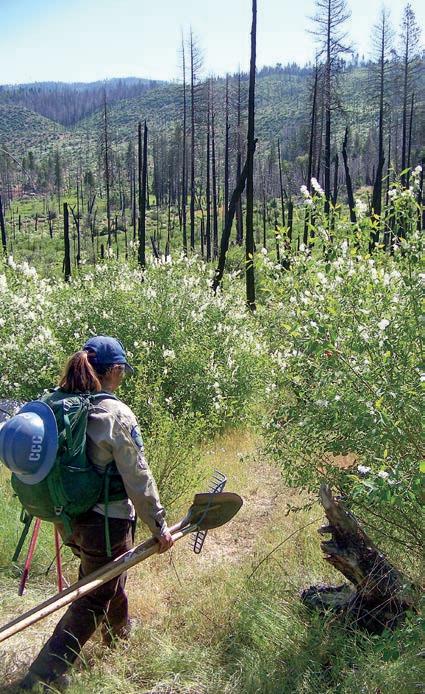
sections and added features to prevent additional erosion.
In some cases, the backcountry trail work donors support goes beyond restoring an existing route. Generations of people hiking up Mt. Dana, near Tioga Pass, left a network of informal footpaths that threatened vulnerable highelevation plants. Starting in 2011, crews created a safe, sustainable route to the summit: They pieced together existing paths to formalize a single plant-friendly trail, removed the remaining hiker-generated routes and restored the rocky slopes’ natural topography.
Donor-supported projects in Upper Cathedral Meadow and Lyell Canyon have taken similar approaches, repairing ruts forged by boots and hooves, and channeling hikers onto relocated trails that avoid sensitive habitat.
The next time you head out for a hike in the Yosemite Wilderness, look for evidence of the careful work that goes into tending Yosemite’s less traveled trails: stone steps and walls, water-diverting ditches and bars, switchbacks and smooth tread. Your support has improved backcountry trails in every corner of the park — and will continue to benefit hikers and habitat, alike, for years to come.
A longer version of this story first appeared on the Yosemite Conservancy blog in 2019.
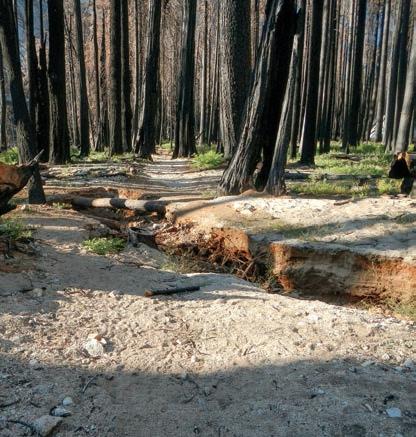

Through Yosemite’s decades-long, donor-supported partnership with the California Conservation Corps (CCC), hundreds of young adults have had the chance to spend a season living and learning in the park — and have completed thousands of miles of wilderness trail work. LEFT A CCC crew member hikes to a work site in the Tuolumne River watershed, carrying tools for a day of clearing brush and readying trails for the summer season.it.
ABOVE In Lost Valley, CCC participants filled in a deep gorge across the trail and improved drainage along the route to help prevent future erosion.
HOW BOARDWALKS PROTECT ECOSYSTEMS — AND BENEFIT FROM YOUR SUPPORT

oardwalks play a critical role in Yosemite’s trail system: They let people experience wetland ecosystems without disturbing the complex world underfoot.
Hikers walking through meadows can crush plants, compress soil and disrupt natural processes — and end up with soggy socks. Boardwalks allow water to flow freely, saturating soil and quenching roots, and keep boots dry, safely away from flora and fauna below.
Our donors have supported the construction and restoration of boardwalks throughout the park. Here are some to look for on your next visit!

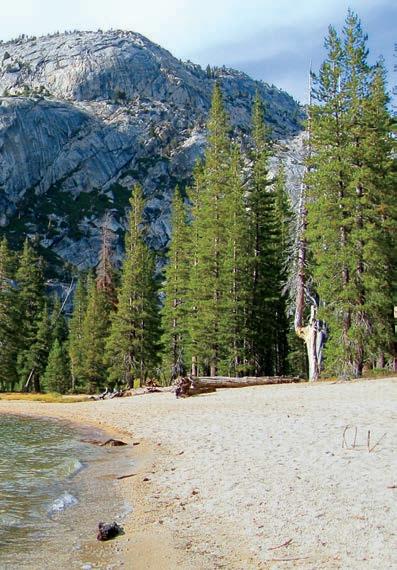
At Tenaya Lake’s east end, crews removed sodden paths that once cut through vegetation, and built raised boardwalks and bridges, creating a more enjoyable and habitat-friendly route to the East Beach.
The east end boardwalk and a similar walkway at the west end, which replaced a paved causeway, are part of a broad effort to improve the Tenaya Lake trail system and protect shoreline habitat.
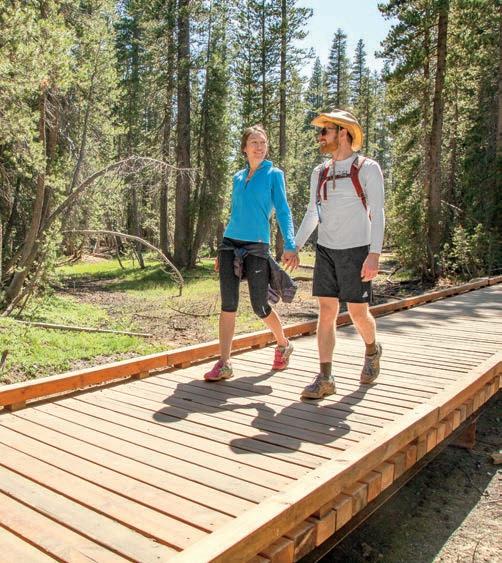
Thanks to donor-funded Valley boardwalk projects, visitors can meander across meadows to gape at waterfalls, look for monarchs and red-legged frogs, and observe seasonal shifts — all without trampling wetlands below.
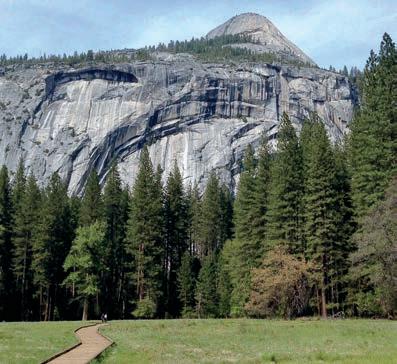
In Stoneman Meadow, donorsupported crews replaced pavement and informal footpaths with a sustainable walkway that protects surrounding habitat. Other Conservancy-funded projects have moved boardwalks away from eroding riverbanks, repaired damaged wood, and more.
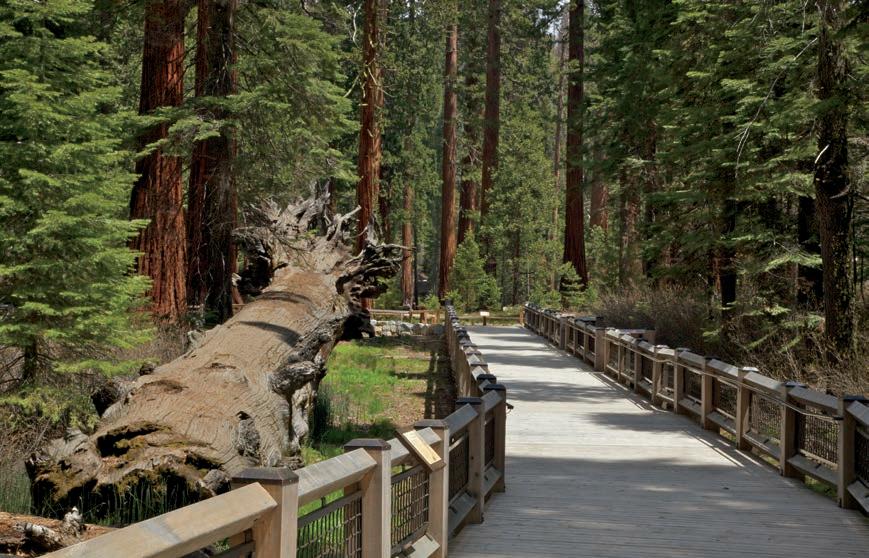

The multiyear Mariposa Grove restoration project swapped paved roads for trails, bridges and boardwalks. You’ll find carefully crafted boardwalks in several parts of the grove, including beside the Fallen Monarch . Just a few years ago, asphalt quashed roots and soil beside the toppled giant; now, plants are flourishing, and a once-buried stream dances beside the planks.
Tenaya Lake’s West End Boardwalk Tenaya Lake’s East Beach Yosemite ValleyConservancy guides share picks for seasonal hikes in the park

The naturalists who lead our Outdoor and Custom Adventures offer expertise in every season, whether you join them for a snowshoe stroll, a summer summit or anything in between. Get inspired for your next outing on the trails with these recommendations from four of our guides!

GUIDE: Tom Bertrand
TRAIL: Laurel Lake and Lake Vernon (3,900'–6,570')
Explore Yosemite’s quiet side on a hike or backpack from Hetch Hetchy. Take a 15- to 16-mile out-and-back trek to Laurel Lake, or tackle a 28-mile loop that also includes Lake Vernon and Rancheria Falls. (For the longer loop, check conditions for the Wapama Falls crossing in advance.)
Your rewards for double-digit miles: solitude, wildflowers and diverse ecosystems — including habitat rebounding in the Rim Fire’s wake. As you watch snowmelt in creeks and rivers, consider how that water affects people and places beyond the park.

GUIDE: Margaret Glover
TRAIL: Sentinel Dome and Taft Point (7,700'–8,120')
Explore the Valley’s south rim in relative quiet after summer’s bustle fades. This 5-mile loop from Glacier Point Road leads to two spectacularly scenic spots: Taft Point, with its famed fissures, and Sentinel Dome. Atop the dome, use the large brass compass to get oriented amid 360-degree views.
Along the trail, look for Jeffrey pines, identifiable by their puzzle-piece bark, three-needle structure and butterscotch aroma. If you’re planning this hike in late autumn, check conditions first — the road closes to cars when snow piles up.

GUIDE: Andrea Canapary
TRAIL: Gaylor Lakes (9,950'–10,550')
On this can’t-miss hike by Tioga Pass, you’ll find impressive views, mountain mammals and serene alpine lakes.
For the short-but-steep high-elevation route, bring layers for variable weather, plus plenty of water, sunscreen and bug protection. Look for marmots sunbathing before they hibernate through cold months, plants flowering and dispersing seeds during the short warm-weather window, and pikas dehydrating vegetation to use as a winter food source.
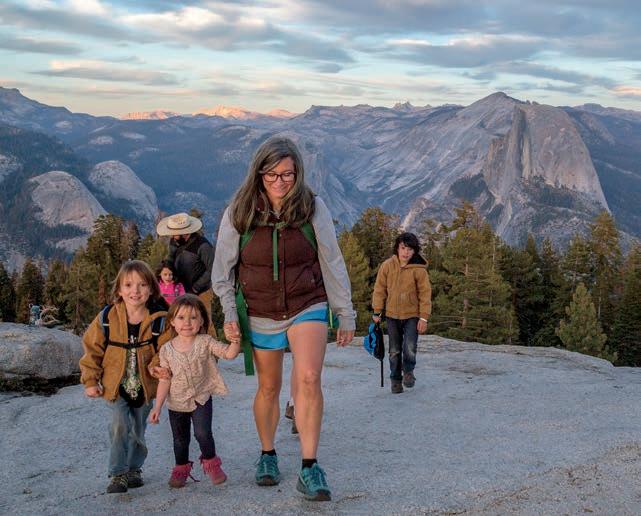
GUIDE: Dick Ewart
TRAIL: Dewey Point (7,200'–7,600')
Glacier Point Road closes to vehicles in winter but stays open for human-powered recreation. Take advantage of the road’s groomed snow to hone skiing or snowshoeing skills before tackling surrounding trails.
The 7- to 8-mile round-trip ski or snowshoe from Badger Pass to Dewey Point leads up the road, through a frosted forest and to the Valley’s edge, directly across from El Capitan. Bring water and warm clothing, picnic on a blanket of snow, and allow ample time — the winter sun sets early!
“Volunteering in Yosemite deepens your connection to this place.”— SALLEY MARTINEZ Yosemite National Park, Volunteer Operations


hether they’re sharing Preventive Search and Rescue (PSAR) tips, pitching in on restoration projects, or helping visitors explore and enjoy the park, volunteers play a vital role in Yosemite.
We asked Yosemite National Park’s Sally Martinez, who oversees parkwide volunteer operations, and Yosemite Conservancy’s Mark Marschall, who runs our volunteer programs — monthlong visitor information assistants, work weeks and corporate work weekends — about the difference volunteers make in the park.
Q :: Why are volunteers important to Yosemite?
Martinez :: People who volunteer in the park — whether they’re schoolchildren or retirees, give one or 500 hours — are a backbone of support. Not only do they welcome visitors, count bighorns and design engineering projects, they also embody stewardship of this national treasure, becoming caretakers of and advocates for Yosemite.
Q :: How do volunteers help improve hiking experiences?
Marschall :: Conservancy volunteers working at PSAR stations and information booths explain potential trail hazards, distances and elevation to help people prepare for hikes.
Our volunteers also play a key role in trail rehabilitation. In 2019, for example, work week crews in Mariposa Grove, the Valley and elsewhere built rock steps, removed fallen trees and restored informal “use trails” to their natural state.
Martinez :: Volunteers also work on trails climbers use to access cliffs, concentrating impacts on a single path to let surrounding vegetation rebound.
Q :: Where else can people see the impact of volunteers in Yosemite?
Marschall :: It’s hard to find anywhere volunteers don’t have an impact. They work at entrance stations, in campgrounds and in visitor centers; help with bear management and check Half Dome permits; and work in the wilderness, supporting patrols, research and restoration. Yosemite would be a much different place without volunteers!
Q :: What’s your elevator pitch to potential volunteers?
Marschall :: Spend a week or a month in the park, work and camp with fellow Yosemite-lovers, and transform yourself into someone who makes the park a better place. It will be an unforgettable experience.
Martinez :: Volunteering in Yosemite deepens your connection to this place. If the National Park Service mission — to preserve our shared heritage and allow for its enjoyment by current and future generations — resonates with you, then volunteering is a way to live out what is important to you.
“Spend a week or a month in the park, work and camp with fellow Yosemite-lovers, and transform yourself into someone who makes the park a better place.”
— MARK MARSCHALL Yosemite Conservancy, Volunteer Programs

With Marschall’s help, our volunteer program has expanded to provide additional support for restoration work and Preventive Search and Rescue (PSAR) activities. ABOVE A Conservancy volunteer shares PSAR safety tips with hikers. RIGHT Conservancy work week volunteers pitch in on a project to improve a climbingaccess trail near El Capitan.


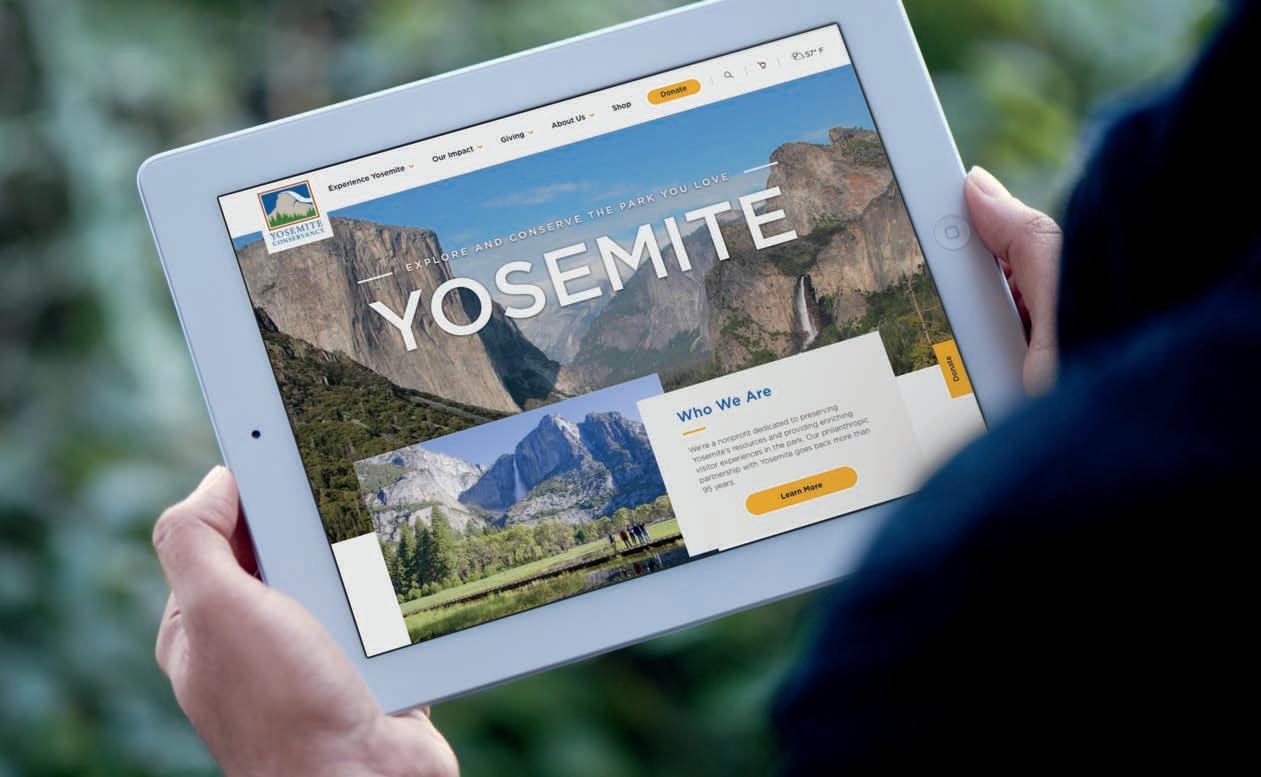

ead to yosemite.org to see our freshly redesigned website, where you can:
• Easily make your annual donation or set up a monthly gift.
• Browse our calendar of upcoming Yosemite events and activities.
• Register for Outdoor Adventures, art workshops and other programs in the park.
• Explore current and past projects made possible by your support.
• Watch our four real-time Yosemite webcams.
• Read our blog posts, including Q&As with Yosemite experts and stories about how donors make a difference.
• Check out Conservancy updates and publications (including past issues of this magazine).
The redesigned site offers all your favorite Conservancy content in a streamlined, user-friendly format. We’re excited to welcome you to yosemite.org!
A NEW TRAIL TRACES A PIECE OF YOSEMITE’S HISTORY

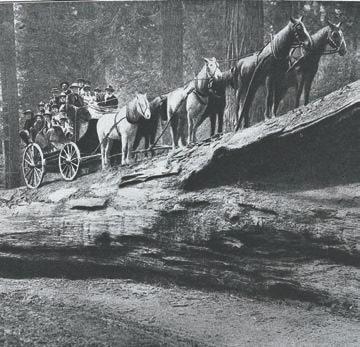
Long before automobiles entered Yosemite, people relied on horse-drawn transport. The Washburn Road carried stagecoach travelers to Mariposa Grove, home to hundreds of giant sequoias — including the massive Fallen Monarch — that continue to awe and inspire today’s visitors.
he new Washburn Trail from Yosemite’s Mariposa Grove Welcome Plaza passes manzanita, azalea-lined streams and expansive views of forested hills — and traces a slice of history.
As people hike the 2-mile trail, which opened in late 2018 after two years of donor-supported work, they follow part of the footprint of the Washburn Road, a 19th-century stagecoach route that linked Wawona and Mariposa Grove, and featured stone walls built by Chinese workers.
The largely unheralded role those builders and other Chinese laborers played in Yosemite is coming to light, including through educational signs that will be installed on the trail, and at the nearby Pioneer Yosemite History Center, where donor-supported crews are restoring a building that once served as a Chinese laundry. With your support, crews are also expanding History Center exhibits to share other untold Yosemite stories, including about American Indians and Buffalo Soldiers, encouraging today’s visitors to learn about, and from, the park’s past.
CYCLING
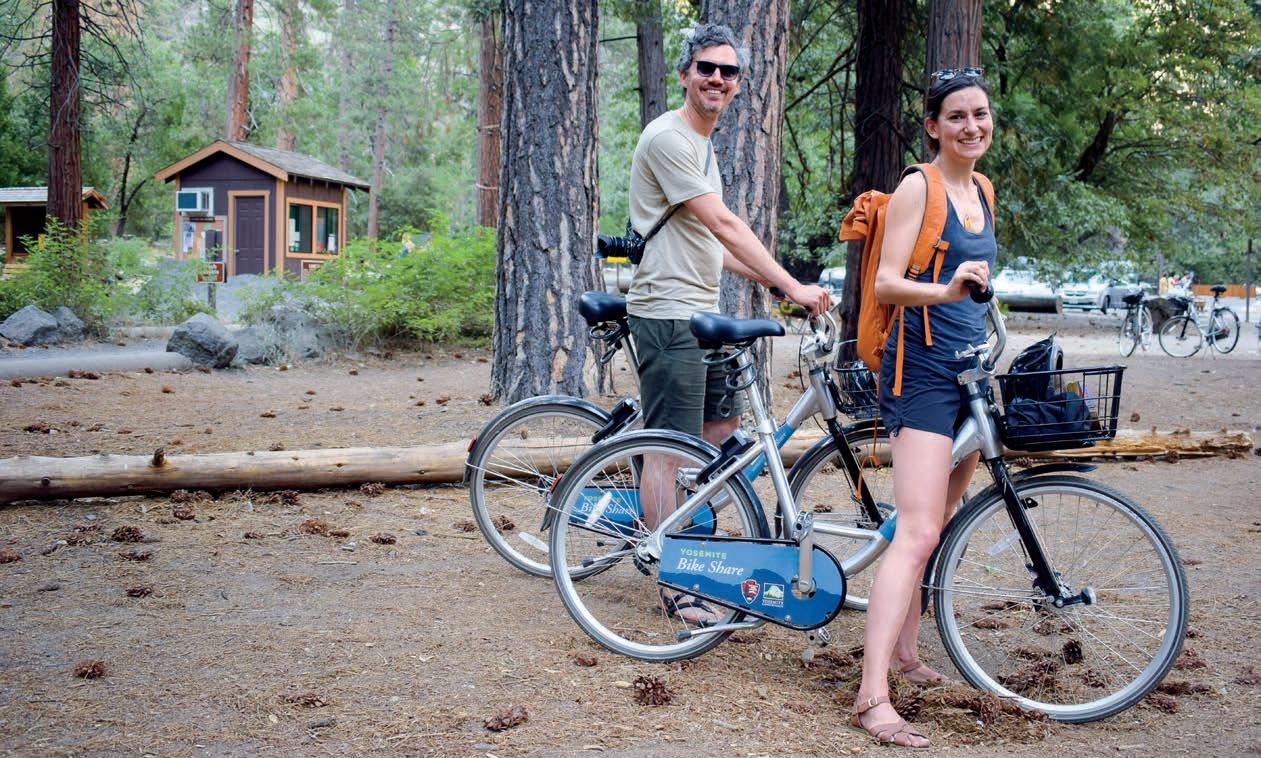
icture this: You’re enjoying a summer day at Sentinel Beach and want to zip back to Yosemite Village to catch the evening theater show. You pull out your phone and, with a quick tap, unlock your vehicle: a blue bicycle.
As you pedal on flat paths, you pass other people on blue bikes, all enjoying the fresh air and traffic-free ride — and all, like you, using the Yosemite Bike Share.
The bike share, which lets people rent bikes by the hour via a mobile app, launched as a donor-funded pilot in 2018 to help summer Valley visitors cover short distances without relying on cars. In 2019, with your support, the bike-share team added more bikes, evaluated pickup locations, and introduced an improved app.
By expanding and enhancing the bike share, the team is working toward a big goal: to help reduce congestion and pollution in the Valley by providing a fun, environmentally sustainable way to get around.
Thanks to Peet’s Coffee for supporting the bike-share program.
USE THE BIKE SHARE
1. Download the bikeshare mobile app (“Yosemite Bike Share” for Android or “Yosemite Bike Sharing” for iOS).
2. Head to a pickup location, such as Camp 4.
3. Use the app to unlock your bike by scanning a QR code on the handlebars.
4. Put on your helmet, and pedal to your next stop!


TOP WildLink, a donor-supported NatureBridge and National Park Service program, helps high school students connect with nature through a variety of activities, including backpacking trips.
BOTTOM In recent decades, bear-proof food canisters, required hardware for overnight trips in the Yosemite Wilderness, have helped spur a dramatic reduction in bear-related incidents. Fees from the Conservancy-run canister-rental program help fund work in the park.
YOUTH PROGRAMS INSPIRE NEW ENVIRONMENTAL STEWARDS
ddie Phosalath grew up in a central Californian “concrete jungle.”
At age 17, he got to visit Yosemite — his first national park — with WildLink, a youth program your gifts support. He’d seen “amazing natural places on a computer screen,” he recalls, but felt disconnected from them. “That all changed with one trip to Yosemite.”
Donor-funded youth programs help kids and teens get outside to learn on the trails. Whether on a Junior Ranger walk, a Parks in Focus photography hike or a weeklong WildLink backpacking trip, participants learn to appreciate and protect the natural world.
Backpacking with WildLink shaped Eddie’s next steps: He’s now studying ecology at the University of California, Merced, where he participates in the donorsupported Yosemite Leadership Program; he’s also an advocate for environmental stewardship, regularly reminding friends and family to “Leave No Trace.”
Eddie’s story is one of thousands made possible by youth programs in the park — and by your support.
FROM PERMITS TO FOOD STORAGE, HELPING
BACKPACKERS — AND THE BACKCOUNTRY


TOP The Conservancy’s wilderness team manages the Ostrander Ski Hut, which was built in 1941 and remains a beloved winter destination for advanced skiers willing to tackle a challenging cross-country trek.
BOTTOM In recent decades, bear-proof food canisters, required hardware for overnight trips in the Yosemite Wilderness, have helped spur a dramatic reduction in bear-related incidents. Fees from the Conservancy-run canister-rental program help fund work in the park.
ackpackers flock to Yosemite Wilderness, summits, solitude and inspiring beauty. As tens of thousands of people hit the park’s backcountry trails for overnight trips — the number reached nearly 125,000 in 2018 and has surpassed 200,000 in recent years — the Conservancy’s wilderness team works hard behind the scenes to keep hikers safe and ecosystems healthy.
Our organization’s wilderness work stretches back decades, from taking on management of the historic Ostrander Ski Hut in the 1980s, to stepping in to support National Park Service operations at the then-new Valley Wilderness Center in the mid-1990s.
Today, our wilderness team helps manage the parkwide permit system, processing more than 95,000 requests each year to prevent overcrowding and minimize impacts from backcountry travel. The team also runs the park’s rental program for bear-proof canisters, which keep food and other scented items safely out of bears’ reach, and are required hardware for Yosemite backpackers.
Whether they’re answering questions, offering route guidance and handling walk-in permits at the Wilderness Center, or assessing conditions out on the trails, the team is dedicated to helping backpackers have safe, enjoyable experiences — and to protecting Yosemite’s wildest places.

COLD-WEATHER OUTDOOR ADVENTURES
DRAW YOU INTO YOSEMITE’S QUIET SEASON
s temperatures drop and daylight dwindles, a seasonal quiet descends on Yosemite. The stream of visitors slows. Songbirds head south. Snow softens the landscape.
Amid this hush, the winter world awakens. Drumming woodpeckers are visible through bare branches. Feathery hoarfrost blooms on cold mornings. Coyotes wait in meadows, ears pricked for small mammals scurrying under the snow.
Experiencing Yosemite during this quiet season can feel like entering a secret world — and Conservancy naturalists are well-equipped to show you the way on cold-weather adventures. Join our guides to explore Mariposa Grove and learn how the Sierra snowpack supports giant sequoias, take a heart-pumping trek to Dewey Point’s majestic views, or enjoy a private Custom Adventure hike or snowshoe to a destination of your choice.
No matter where you go, you’ll gain winter travel skills, explore how plants and animals adapt to cold and snow, and learn from naturalists whose Yosemite knowledge spans every season.
December 19, 2019
Sequoia Stroll in Mariposa Grove
January 25, February 8 and March 14, 2020
Snowshoe Yosemite: Valley Views from Dewey Point
February 22, 2020
Winter Wonder: Tuolumne Grove and Crane Flat
March 29, 2020
Yosemite’s West End: Naturalist Photography Walk
April 19, 2020
Wildflower Wonder: Introduction to Birding and Botany
April 24-26,2020
Yosemite Day Hikes: Historic Roads
Visit yosemite.org to sign up for an adventure, browse our program calendar, or create a custom experience.

CHAIR'S & PRESIDENT'S NOTE
e’ve marked several notable public lands milestones in recent years, including the Yosemite Grant Act’s 150th anniversary and the National Park Service’s 100th birthday. 2018 brought its own milestones: the 150th anniversary of John Muir’s first Yosemite trip, and the 50th of the National Trails System and Wild and Scenic Rivers acts.
Park-related anniversaries are worth commemorating, of course, but we don’t have to wait for those occasions to reflect and rejoice; every year — every month — brings something to cheer about. In this report, we’re celebrating the key to that success: you! In 2018, you helped us provide $12 million in total support to the park, through more than three dozen grants, enriching programs, wilderness services and more.
With your help, park crews measured glacial ice on Yosemite’s eastern edge and surveyed natural resources in Ackerson Meadow. They studied butterflies and songbirds, restored areas affected by backcountry travel, and installed roadside “speed feedback” signs to protect wildlife.
Your gifts supported programs that improve experiences for the park’s millions of visitors and inspire the next generation. Yosemite’s Preventive Search and Rescue team promoted seasonal safety, thousands of kids earned Junior Ranger badges, and undergraduates explored park-related careers.
Meanwhile, more than 800,000 people benefited from Conservancyrun programs and services, by participating in theater, art and adventure programs; shopping in bookstores; picking up permits and bear-proof canisters; or getting guidance from volunteers.
2018 also marked a notable end — and a beginning. In mid-June, Mariposa Grove reopened after a multiyear effort to restore giant sequoia habitat; in autumn, we celebrated the groundbreaking of the Bridalveil Fall restoration project.
While we can’t possibly fit all our gratitude into this report, we hope these pages offer a glimpse into the many ways your gifts made a difference.
 Bob Bennit, Chair Frank Dean, President
Bob Bennit, Chair Frank Dean, President
n 2018, your support helped restore trails and ecosystems, advance research and enhance visitor experiences. You’ll see the results of your donations in new Search and Rescue tent housing, on improved backcountry trails, and in the thousands of historical Yosemite images now available on the digital NPGallery. You might hear about the impact of your gifts, too, from people who connected with Yosemite through the Parsons Memorial Lodge series, live theater shows or Conservancy art workshops — or from youth-program participants whose first camping trips were made possible by your support.

More than 300 middle and high school students from underrepresented California communities experienced Yosemite through Adventure Risk Challenge, WildLink and Parks in Focus, three of the youth programs donors supported in 2018.


Mariposa Grove reopened in June 2018, following the largest restoration project in park history, which included removing pavement, installing boardwalks and educational displays, and rehabilitating four acres of giant sequoia habitat.
Our seasonal volunteers donated more than 14,000 hours to the park, sharing their time and talents to provide vital information to visitors, support Preventive Search and Rescue operations, restore wetland habitat, and more.
Park crews, including young adults from the California Conservation Corps, improved more than 118 miles of trails throughout Yosemite, from the remote backcountry to the new Washburn Trail in Wawona.


Biologists working to restore and protect the park’s native aquatic species released 125 California red-legged frogs in Yosemite Valley, studied western pond turtle genetics and conducted surveys of endangered yellowlegged frogs.
As of Dec. 31, 2018
As of Dec. 31, 2018


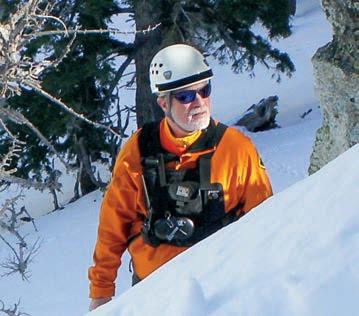
From volunteering to foundation giving, a lifelong outdoor-lover gives back
ames (Jim) Frank believes in the power of getting people outside.
“Providing people, especially the next generations, with a wilderness experience is the best way I can think of to care for our species and the Earth,” he says.
An avid adventurer, longtime Search and Rescue volunteer and president of his late father’s Raintree Foundation, Jim has spent decades helping others find inspiring experiences in national parks that have captured his heart, including Yosemite.
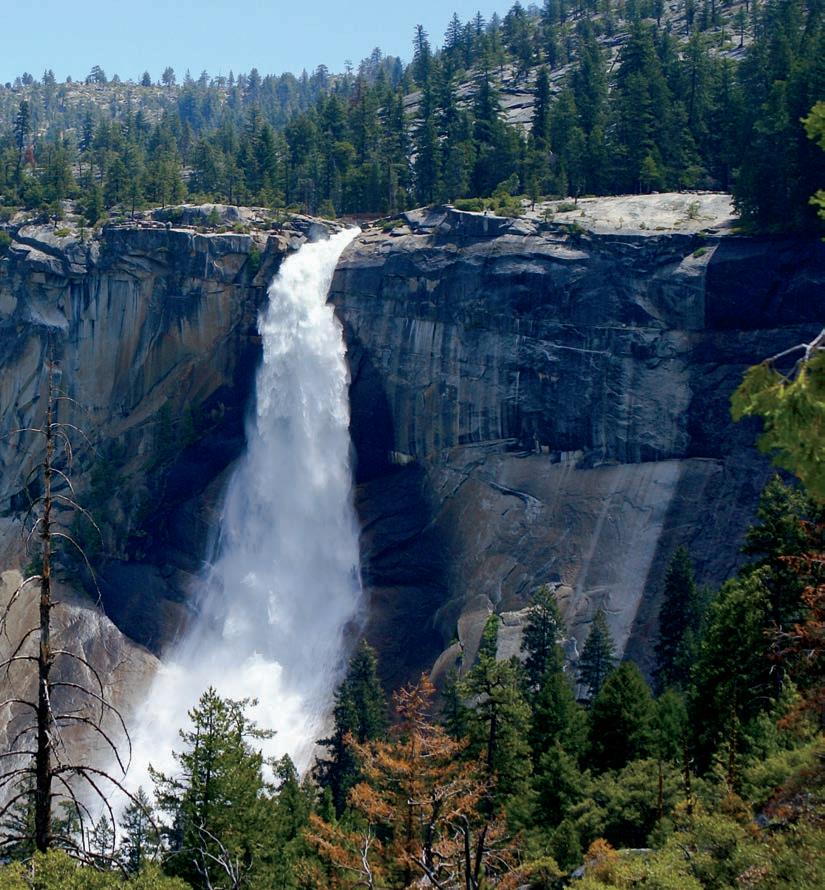
Jim’s earliest memory of Yosemite is of swimming at the pool and staying at Curry Village as a child in the 1950s, but his Sierra horizons soon stretched into the wilderness, as he backpacked on the John Muir Trail, camped in Tuolumne Meadows and climbed Cathedral Peak. Adventures in Yosemite and beyond prompted Jim to become a Santa Barbara–based Search and Rescue volunteer and, in 1978, to establish the California Mountain Company (now CMC Rescue, Inc.), which provides rescue gear and education.
Years later, while volunteering on a search for a missing Yosemite hiker, Jim met California Conservation Corps (CCC) members who expressed gratitude for the Conservancy-supported trail projects that let them work in the park. For Jim, who was supporting the CCC crew’s work as a Conservancy donor, their enthusiasm reinforced his dedication to helping people connect with nature in meaningful, safe and environmentally sustainable ways.
BELOW By supporting safety-focused activities, including Preventive Search and Rescue programming, a PSAR Junior Ranger booklet, and Search and Rescue team housing, Jim and the Raintree Foundation help Yosemite visitors enjoy positive, safe outdoor experiences.

That commitment anchors Jim’s philanthropy. The Raintree Foundation has supported an array of Conservancy projects that help people experience, learn about and take care of Yosemite, including CCC and other youth programs, trail improvements, Preventive Search and Rescue, and restoration work at Yosemite Falls, Bridalveil Fall and Mariposa Grove.
By funding park-based restoration and education — and by sharing his story — Jim hopes to encourage people to experience and protect natural landscapes, and, ultimately, to inspire the next generation to become passionate stewards of our parks and planet.
Inspired by Jim Frank's story? Give today at yosemite.org.

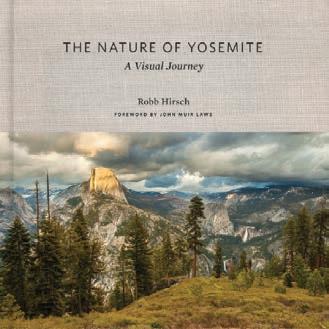
EXPLORING AN ICONIC PLACE THROUGH A NATURALIST’S EYES
obb Hirsch’s years of exploring and photographing the Sierra Nevada anchor The Nature of Yosemite, a “visual journey” that offers fresh perspectives on one of the world’s most celebrated landscapes.
This new Conservancy-published collection of images and essays invites us to see Yosemite through varied lenses: The Nature of Yosemite encompasses the park’s natural features — cliffs and domes, giant sequoias, alpine lakes — as well as its character, as a living place imbued with personality and memory.
Each page encourages you not just to appreciate Yosemite’s beauty, but to explore with all senses, through photos of familiar icons and remote wilderness, wrestling marmots and swirling snowmelt, gnarled bark and fiery lilies. Thirteen essays on geology, water, flora and fauna, and history, by people with deep knowledge of the park, pair with Hirsch’s images to create a compelling and comprehensive tale of life and land.
Proceeds from this book, and from all Yosemite Conservancy retail items, support important work in the park. To purchase, visit one of our bookstores in Yosemite, or shop online at yosemite.org/shop.
Yosemite Conservancy donors receive invitations throughout the year to join National Park Service leaders and expert naturalists on project tours, hikes and site visits; at private receptions and dinners; and at other special events inside and outside the park. These gatherings provide opportunities for donors and friends of the Conservancy to connect with other like-minded individuals who are passionate about making a difference in Yosemite.
For more information about our donor events and activities, please contact Alison Dombroski at adombroski@yosemite.org or 415-434-8446 x333.

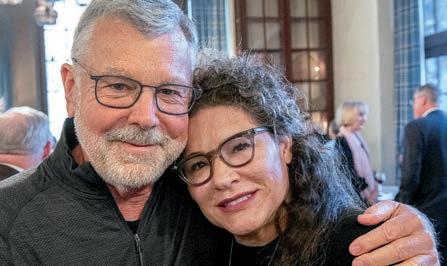

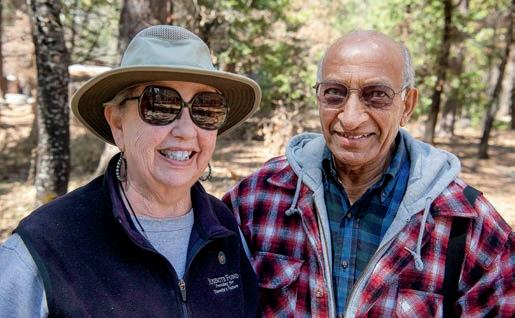




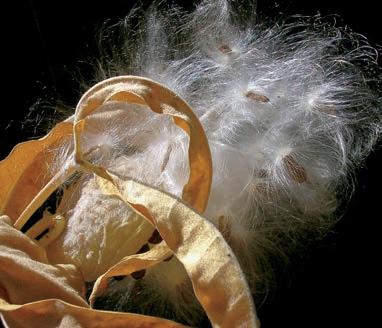

Magazine of Yosemite Conservancy, published twice a year.
EDITORIAL DIRECTOR
Jennifer Miller
MANAGING EDITOR
Alexa Schneier
CONTRIBUTING WRITERS
Frank Dean Elizabeth Sherer
Gretchen Roecker
DESIGN
Eric Ball Design
STAFF :: San Francisco
Frank Dean, President & CEO
Jerry Edelbrock, Vice President & COO
Caitlin Allard, Major Gifts Officer – Northern California
Alison Dombroski, Campaign & Events Manager
Edin Draper-Beard, Executive Affairs Manager
Laura Garland, Director of Accounting
Kevin Gay, Chief Financial Officer
Marion Ingersoll, Development Director
Pongphat Kimpol, Data Services Assistant
Holly Kuehn, Development & Donor Services Assistant
Eryn Ligon, Data Services Manager
Isabelle Luebbers, Annual Giving Director
Jennifer Miller, Marketing & Communications Director
Laurie Peterson, Institutional Giving Officer
Xoe Riphenburg, Dvelopment Data Entry &
Administrative Assistant
Gretchen Roecker, Senior Communications Manager
Alexa Schneier, Marketing Manager
Elizabeth Sherer, Digital Media & Content Coordinator
STAFF :: Yosemite
Adonia Ripple, Director of Yosemite Operations
Kristin Anderson, Art Programs Manager
Greg Archer, Retail Accounting Coordinator
Nicole Brocchini, Museum Store Supervisor
Emily Brosk, Warehouse Coordinator
Kylie Chappell, Adventures Programs Manager
Katie Coit, Retail Operations Manager
Pete Devine, Resident Naturalist
Teresa Ellis, Sales Information Assistant
Schuyler Greenleaf, Projects Director
Ryan Kelly, Projects Manager
Olotumi Laizer, Valley Sales Supervisor
Mark Marschall, Volunteer Programs Manager
Cassie May, Program Coordinator, Adventures
Simon McIntosh, Wilderness Programs Manager
Madison Smith, Program Coordinator, Wholesale
Lora Spielman, Art Programs Coordinator
Shelly Stephens, Inventory Manager
STAFF :: Pasadena
Patti Johns Eisenberg, Senior Major Gifts Officer
– Southern California & National
Autumn.Winter 2019 :: Volume 10. Issue 02 ©2019
Federal Tax Identification No. 94-3058041
THERE ARE MANY WAYS you and your organization can support the meaningful work of Yosemite Conservancy. We look forward to exploring these philanthropic opportunities with you.
Visit yosemite.org
Email info@yosemite.org
Phone 415-434-1782
Development Director Marion Ingersoll mingersoll@yosemite.org 415-434-8446 x324
Annual Giving Isabelle Luebbers iluebbers@yosemite.org 415-434-8446 x313
Major Gifts – Northern California Caitlin Allard callard@yosemite.org 415-434-8446 x318
Major Gifts – Southern California Patti Johns Eisenberg peisenberg@yosemite.org 626-390-1503
FOUNDATIONS & CORPORATIONS
Laurie Peterson lpeterson@yosemite.org 415-434-8446 x328
PLANNED GIVING & BEQUESTS
Caitlin Allard callard@yosemite.org 415-434-8446 x318
Yosemite Conservancy 101 Montgomery Street, Suite 1700 San Francisco, CA 94104 Fax 415-434-0745
HONOR & MEMORIAL GIFTS
Isabelle Luebbers iluebbers@yosemite.org 415-434-8446 x313
GIFTS OF STOCK
Eryn Ligon stock@yosemite.org 415-434-8446 x330
SEQUOIA SOCIETY MONTHLY GIVING
Isabelle Luebbers iluebbers@yosemite.org 415-434-8446 x313
MATCHING GIFTS
Isabelle Luebbers iluebbers@yosemite.org 415-434-8446 x313
VOLUNTEER OPPORTUNITIES
Mark Marschall mmarschall@yosemite.org 209-379-2317 yosemite.org/volunteer
Yosemite Conservancy
101 Montgomery Street, Suite 1700
San Francisco, CA 94104

Honor the park that is close to your heart with a legacy gift to Yosemite Conservancy, and help protect this special place for generations to come.
Naming Yosemite Conservancy as a beneficiary in your will, trust or bank account ensures the park remains well-preserved and accessible for future visitors. Your gift will become part of the legacy fund, which improves the park and makes meaningful work possible.
To find out how you can leave a legacy to Yosemite, contact Caitlin Allard at callard@yosemite.org or 415-434-8446 x318 yosemite.org/plannedgiving